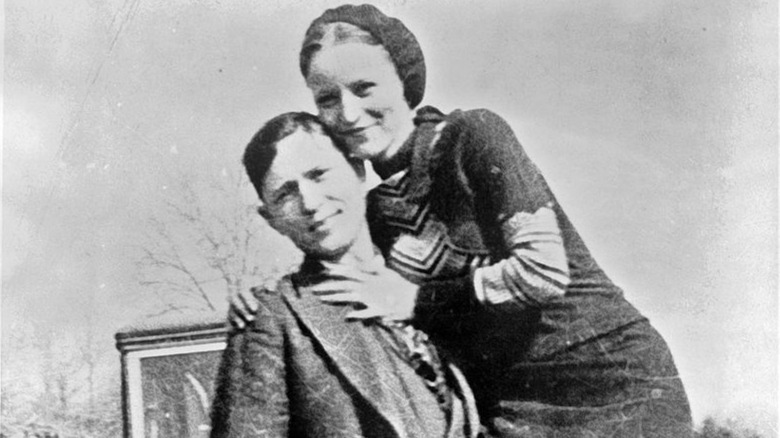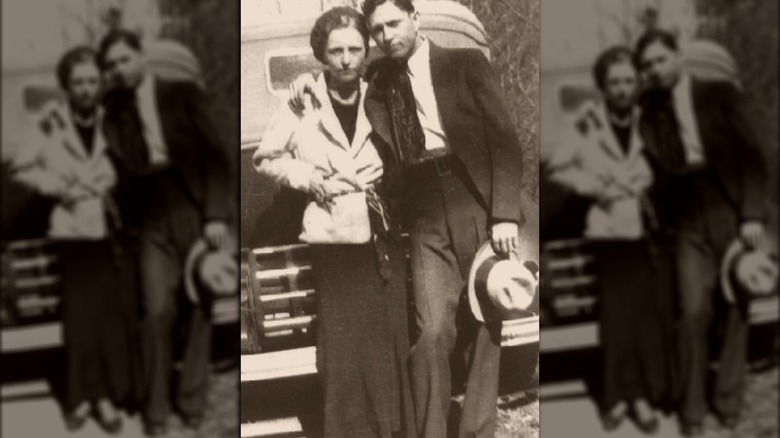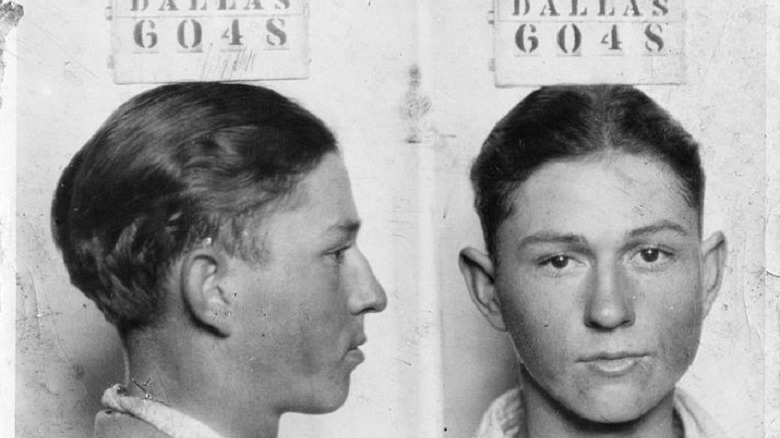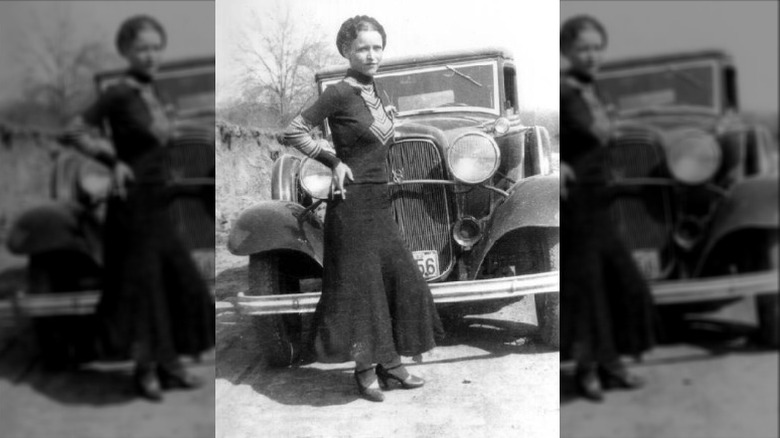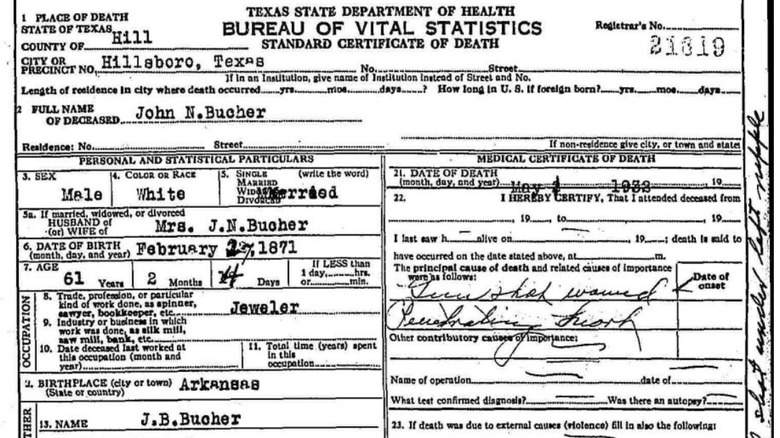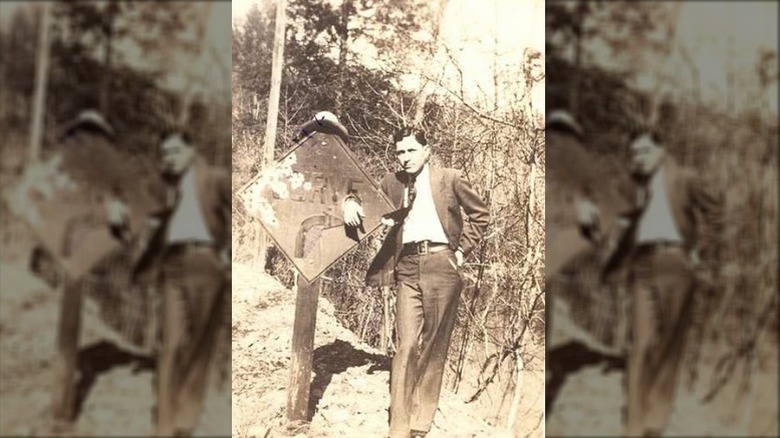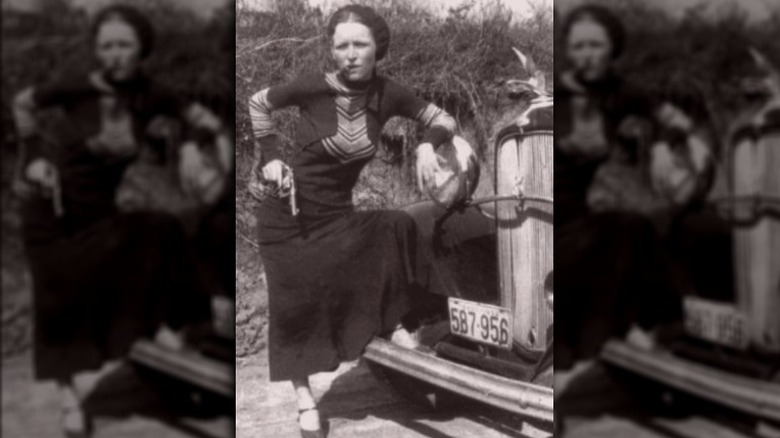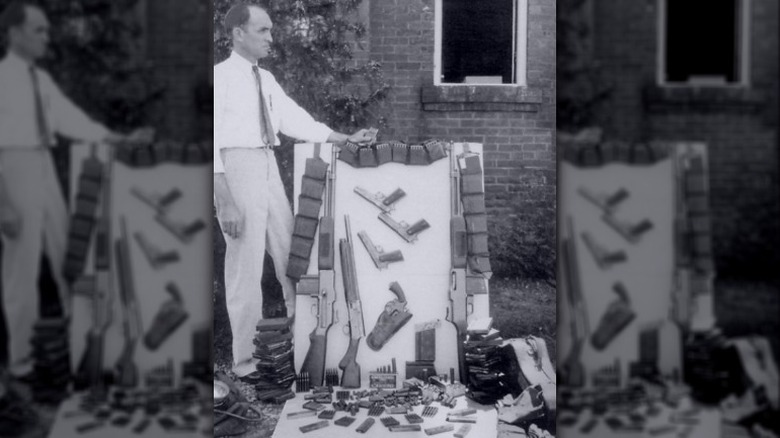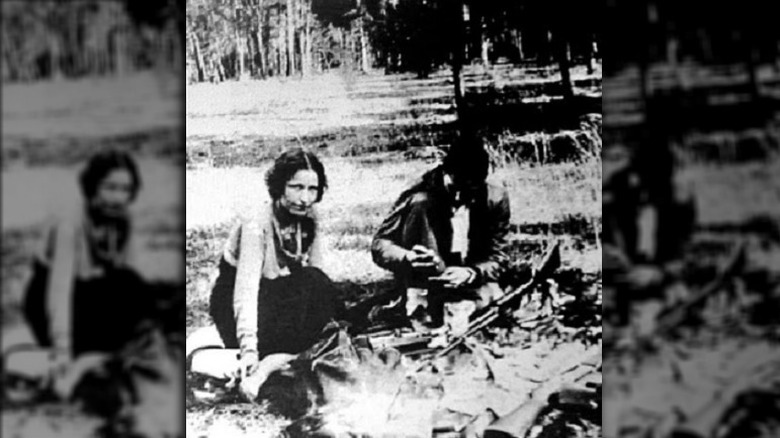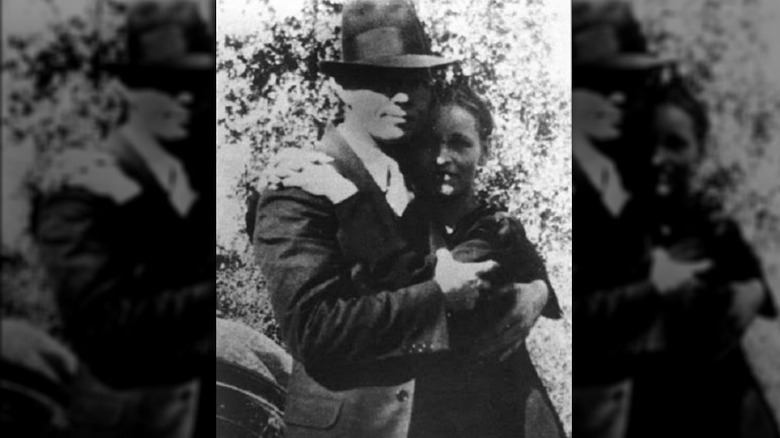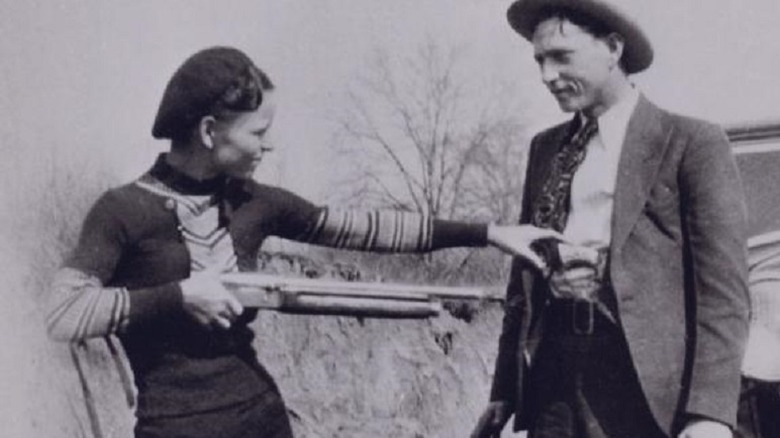Bonnie And Clyde's Most Notorious Crimes
Bonnie Parker and Clyde Barrow are two of the most notorious criminals in American history. Few lawbreakers have entrenched their names into the country's mythos at the level they achieved. Operating during the height of the Great Depression — mainly in New Mexico, Missouri, Oklahoma, and Texas — the couple's criminal activities, which lasted chiefly from 1932-1934, propelled them to a field of notoriety that housed the likes of John Dillinger and "Pretty Boy" Floyd.
Over the years, Bonnie and Clyde's reputation has often been romanticized, with many assuming the criminal duo acted as Robin Hoods of their time, only robbing and targeting big banks and affluent companies. However, this is far from the truth. In fact, the couple's main criminal exploits saw them targeting small local businesses, ruthlessly killing anyone who got in their way. From numerous kidnappings, robberies, and the murders of cops and small-town shopkeepers, Bonnie and Clyde proved to be nothing more than a terrifying menace to society.
The 1930 Jailbreak
One of the infamous duo's earliest crimes together was on March 11, 1930, when Bonnie Parker helped Clyde Barrow break out of jail. The two had only been dating for around two months, when Clyde found himself locked up for burglary in county jail in Waco, Texas, soon to be transferred to a far larger prison in Huntsville. During this time, Bonnie frequently visited her newfound flame, so the stage was set to help Clyde escape before his transfer.
One of his cellmates at McLennan, William Turner, had a revolver hidden away in his East Waco home, and Bonnie was tasked to retrieve it and smuggle it in that day. As Jeff Guinn puts it in his book, "Go Down Together: The True, Untold Story of Bonnie and Clyde," this was a point of no return for young Bonnie Parker: "It was a watershed moment for Bonnie. She'd been reveling in her new real-life role as a convicted criminal's supportive lover, but there was nothing illegal about that. She could walk away from Clyde Barrow anytime she liked, innocent of the slightest wrongdoing."
Bonnie returned to the county jail with the gun hidden away by a belt underneath her dress and successfully passed the revolver off to Clyde, who, along with Turner and a third prisoner, used it to escape. While they were quickly recaptured in a matter of days, their crime would nonetheless foreshadow a criminal partnership and romance that would produce nothing but headlines, murder, and mayhem.
Clyde Barrow's first murder
After his recapture, Clyde Barrow was eventually sent to the notorious Eastham Prison Farm, which Jeff Guinn describes as "the filthiest hellhole in the entire corrupt Texas criminal justice system" (per "Go Down Together"). It was here that Clyde committed his first murder.
Here, a young Clyde encountered Ed Crowder, an inmate who was notorious for violence against other inmates, including Clyde. Crowder frequently beat and raped Clyde for nearly a year. Eventually, another inmate, Aubrey Scalley, urged Clyde to kill Crowder and let him take the fall. Scalley despised Crowder and was already serving a life sentence; taking responsibility for killing another prisoner meant nothing to him.
On October 29, 1931, Clyde baited Crowder to follow him in the shower, where he fatally struck Crowder with a pipe. Scalley quickly appeared and decorated the scene by cutting himself and stabbing Crowder's body multiple times. However, even with Crowder gone, Clyde was forced to continue enduring Eastham's brutal labor system for several months until his mother's vigorous campaigning got him an early parole on February 2, 1932. Despite avoiding a long prison sentence, Clyde was completely transformed by his incarceration. As longtime associate and friend Ralph Fults famously stated, Clyde's imprisonment had turned him "from a schoolboy to rattlesnake."
Bonnie Parker's 1932 capture and the failed Kaufman burglary
Upon his parole from prison, Clyde Barrow quickly reunited with an elated Bonnie Parker. Shortly after his return, she began running with him and his fellow outlaw Ralph Fults. As the story goes, the group made a stop in Kaufman, Texas, and was immediately impressed by the amount of guns at a local hardware store. After stealing some cars in a nearby town, they returned to the store late at night. However, their entry grabbed the attention of its night watchman, Tom Jones, and a shooting match quickly erupted.
The gunfight woke the town up, and the trio's escape was thwarted at every turn, including a downpour that caused the sludge-filled terrain to hamper their escape and ruin their vehicles. The group ended up stealing a couple of mules to get to Kemp, where they then stole a car belonging to a local doctor. But the vehicle broke down after a mile, putting the fugitives in harm's way as an angry posse of townsfolk were close behind. The mob ended up chasing the three criminals, shooting Fults in the arm. Clyde, promising to come back for Bonnie, dashed ahead on his own. She and Fults were quickly overcome and captured. Just months after reuniting with Clyde, Bonnie would find herself behind bars.
The Murder of John Bucher
While Bonnie Parker remained in jail, Clyde Barrow continued running with a crew. In April 1932, he was involved in the killing of John Napoleon Bucher, a shop owner in Hillsboro, Texas, who ran a successful general store and gas pump and also sold jewelry. Clyde had learned of the business years earlier from Bucher's son. Strapped for cash and on the run, Clyde, along with Ted Rogers and Johnny Russell, set their sights on Bucher's store after staking the business out and learning it housed a sizeable safe.
On the evening of the burglary, the trio arrived at Bucher's store, with Clyde serving as the driver. The store was closed at the time, but Bucher woke up and allowed Rogers and Russell in to supposedly buy a .25-cent guitar string. The two criminals pulled out $10, so Bucher headed to the safe to make change, his wife in tow with the combination. When Rogers and Russell pulled out their guns, Bucher attempted to do the same. He was shot and killed by Rogers. According to John Neal Phillips, author of "Running with Bonnie and Clyde: The Ten Fast Years of Ralph Fults," when Rogers and Russell poured out with stolen cash and jewelry, the two immediately informed Clyde of what happened. "Damn!" Clyde replied. "Now we're in for it!"
He wasn't wrong. His photo was one of the first ones picked out by Bucher's wife when the widow was given photos of potential suspects.
The Stringtown Killing and a kidnapping in New Mexico
By August 5, 1932, Clyde Barrow and Bonnie Parker were reunited, after her release from jail. While Bonnie returned to her mother's house, Clyde and his gang headed to Stringtown, Oklahoma, stopping at an outdoor dance to score some booze and steal a car. Such suspicious activity attracted the attention of the local sheriff, C. G. Maxwell, and his deputy, Eugene Moore. When the lawmen approached the strange visitors, they were quickly met with gunfire. Maxwell was seriously wounded, and Moore was killed.
The day after and on the run, Clyde and his associate, Raymond Hamilton, grabbed Bonnie and headed to Carlsbad, New Mexico, hoping to lay low at her aunt's farm. However, Carlsbad was a hotbed of car theft activity, and the car Clyde was driving was stolen — which didn't go unnoticed by Chief Deputy Sheriff Joe Johns. When the lawman confronted the trio, chaos erupted. Bonnie, Clyde, and Hamilton quickly took Johns as their prisoner and left the farm. While the deputy was eventually let go 15 miles outside of San Antonio, the shooting in Stringtown completely altered Clyde's reputation from a run-of-the-mill roaming bandit to a hardened and despicable cop killer.
Despite the brutal murder of Deputy Moore, Bonnie remained steadfastly loyal to Clyde, frequently defending his heinous actions to friends and family. "They made him what he is today. He used to be a nice boy. ... Folks like us haven't got a chance" (per "Go Down Together").
In 1933, Bonnie and Clyde's gang murdered four lawmen
Bonnie and Clyde's gang went on an untethered rampage against law enforcement in 1933. In January, a group of Texas officers traveled to the home of Raymond Hamilton's sister; they hoped to lay a trap there for a notorious bank robber, Odell Chambless, who allegedly visited the house often. However, the officers were instead ambushed by Clyde Barrow, who brandished a shotgun and shot Deputy Malcolm Davis in the chest, killing him.
In April, Clyde, his older brother Buck Barrow, Buck's wife Blanche (who was just as much of a ruthless outlaw as the rest of them), Bonnie Parker, and W.D. Jones rented a garage apartment in Joplin, Missouri. They were quickly found by Missouri lawmen, and a vicious shootout ensued that took the lives of two officers: Detective Harry McGinnis and Constable Wes Harryman.
After the Joplin killings, the Barrow gang went on the lam as news of their duel with the police spread like wildfire across the Midwest. The group's luck took a massive hit in June when Bonnie suffered serious injuries and burns after Clyde crashed their car outside of Wellington, Texas. Suddenly, the Barrow gang found themselves in desperate need of money to get her consistent medical attention, a monumental task for notorious criminals wanted in multiple states. So Buck and Jones went on a robbery spree near Fort Smith, Arkansas, where they killed H.D. Humphrey, a town marshal from Alma.
The robbing of government armories
One of the most glaring and troubling consistencies Bonnie and Clyde displayed during their notorious and ruthless criminal run is that they were always well-armed. Upon their death in 1934, the duo were found to be carrying an entire arsenal of guns, everything from ammunition and pistols to shotguns and rifles.
Ironically, Bonnie and Clyde found the United States government to be their most reliable weapons supplier. Throughout their time on the run, the two made it a habit of robbing National Guard armories across different states. In July 1933, while Bonnie Parker was nursing an injury, Clyde Barrow, along with two associates, stole from the state armory in Enid, Oklahoma. They took five Browning automatic rifles, over 40 Colt .45s, and thousands of rounds of ammunition, which filled their car to the brim. Two months later, another armory, this one in Illinois, was raided, and in early 1934, Bonnie and Clyde, along with three others, were charged for the theft of four rifles and 13 pistols from an armory in Ranger, Texas.
The regular robberies of National Guard armories allowed Bonnie and Clyde to always be prepared for a firefight against law enforcement, and in many cases, the couple was always packing superior heat, courtesy of Uncle Sam.
Bonnie and Clyde's revenge against Eastham led to a successful prison break
One year after the murder of Deputy Malcolm Davis, Bonnie and Clyde achieved one of their most notorious criminal triumphs when they orchestrated a raid on Eastham. Clyde Barrow had long planned to exact some type of revenge against the prison that scarred him for life. However, his and Bonnie Parker's constant clashes with the law and run of bad luck always seemed to keep his apparent dream at bay — until 1934.
On January 14, Bonnie and Clyde put their plan in motion by strategically planting two Colt .45s under a bridge near the prison for a contact inside to retrieve. Two days later, as work crews were outside, the guns were used to ambush and wound Major Crowson, one of the prison's mounted overseers (he would succumb to his wounds 11 days later). During the ensuing commotion, several prisoners escaped, with Clyde covering them with heavy machine gun fire.
The Grapevine Murders in 1934
On April 1, 1934, in Grapevine, Texas, Bonnie and Clyde would once again find themselves facing down the law, except this time, it was against officers who had no idea who they were and were likely only wanting to help them. Spotting a swank black Ford V-8 with fancy wheels parked on a side road, Texas Highway Patrol officers H.D. Murphy and E.B. Wheeler believed they found a group of struggling motorists needing a hand. When the lawmen approached the vehicle, they were instead greeted with gunfire.
Over the years it's been claimed that Bonnie Parker gleefully stood over one of the dying officers before shooting him again. Allegedly, she then famously exclaimed, "His head bounced just like a rubber ball!" (per "I'm Frank Hamer: The Life of a Texas Peace Officer," by John Holmes Jenkins and H. Gordon Frost). However, according to John Neil Phillips' "Running with Bonnie and Clyde," Bonnie did not shoot either of the officers; the author attributes Wheeler's murder to Henry Methvin, a hot-headed thug who ran with the famous duo during their final days, and Murphy's death to Clyde.
Regardless, the Grapevine killings not only propelled Bonnie and Clyde's already nefarious reputation, it put them on the immediate path of killing yet another lawman.
The Murder of Constable William Calvin Campbell
On the run after the Grapevine murders, Bonnie Parker and Clyde Barrow, along with gang member Henry Methvin, were hiding out in Commerce, Oklahoma. Their car wasn't quite inconspicuous, parked close to a mine. When Constable William Calvin Campbell and City Marshall Percy Boyd found the criminals on April 6, they did so not knowing who they were; they assumed they were dealing with a group of raggedy drunks sleeping in the car.
After spotting the lawmen approaching, Clyde attempted to drive away. However, the muddy terrain sent the car sprawling into a ditch. A gunfight ensued. Unfortunately, Campbell and Boyd were severely outmatched; it was their pistols versus the gang's Browning Automatic Rifles. Some accounts claim that Clyde killed Campbell, while Bonnie and Henry wounded Boyd's forehead then took him hostage. Others say that Methvin was the one to kill Campbell. No matter who pulled which trigger, what is certain is that Campbell died from a gunshot wound to the midsection and his partner Boyd did indeed receive a grazing head wound and was then taken hostage and eventually released. Campbell would be the last lawman the infamous duo got killed.
